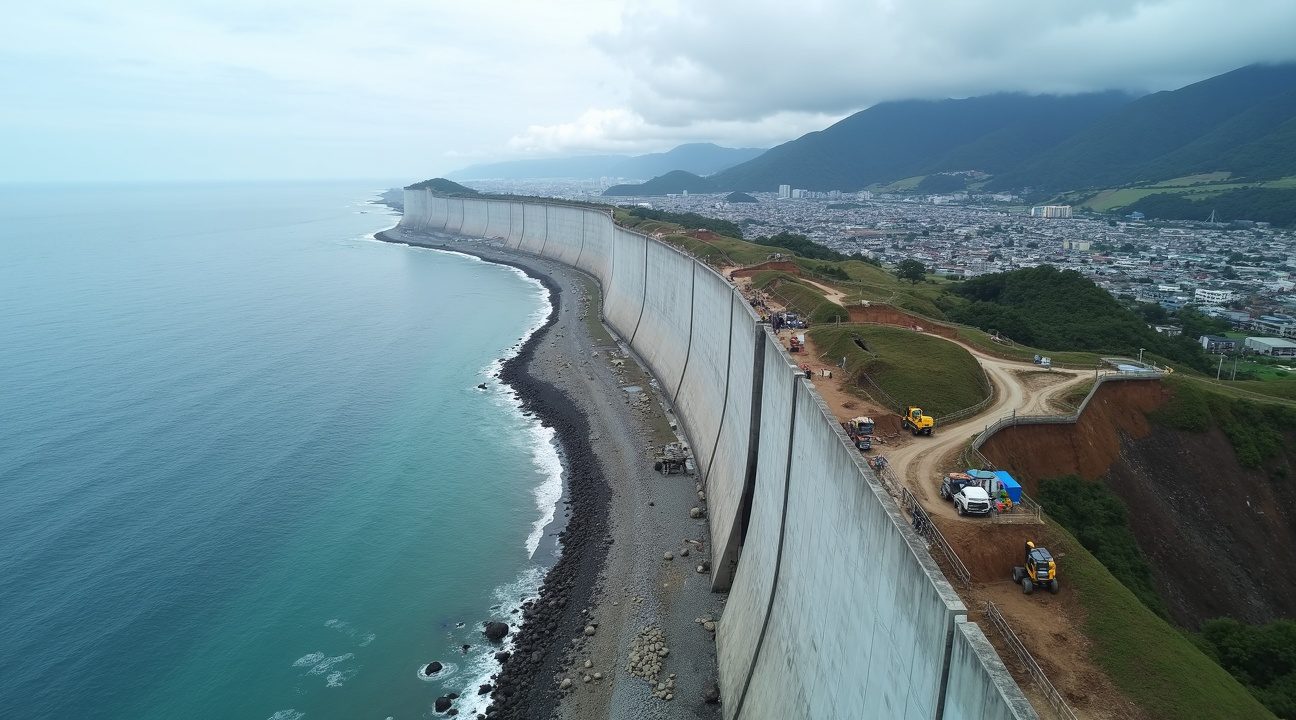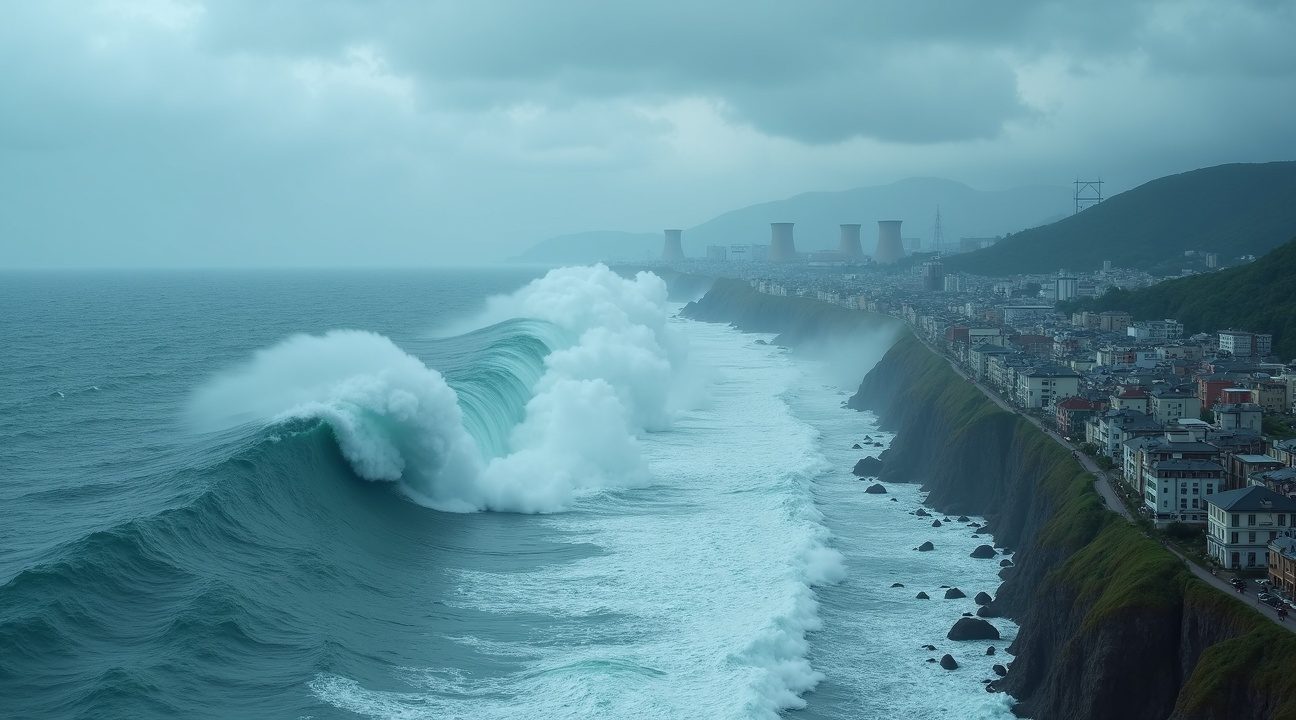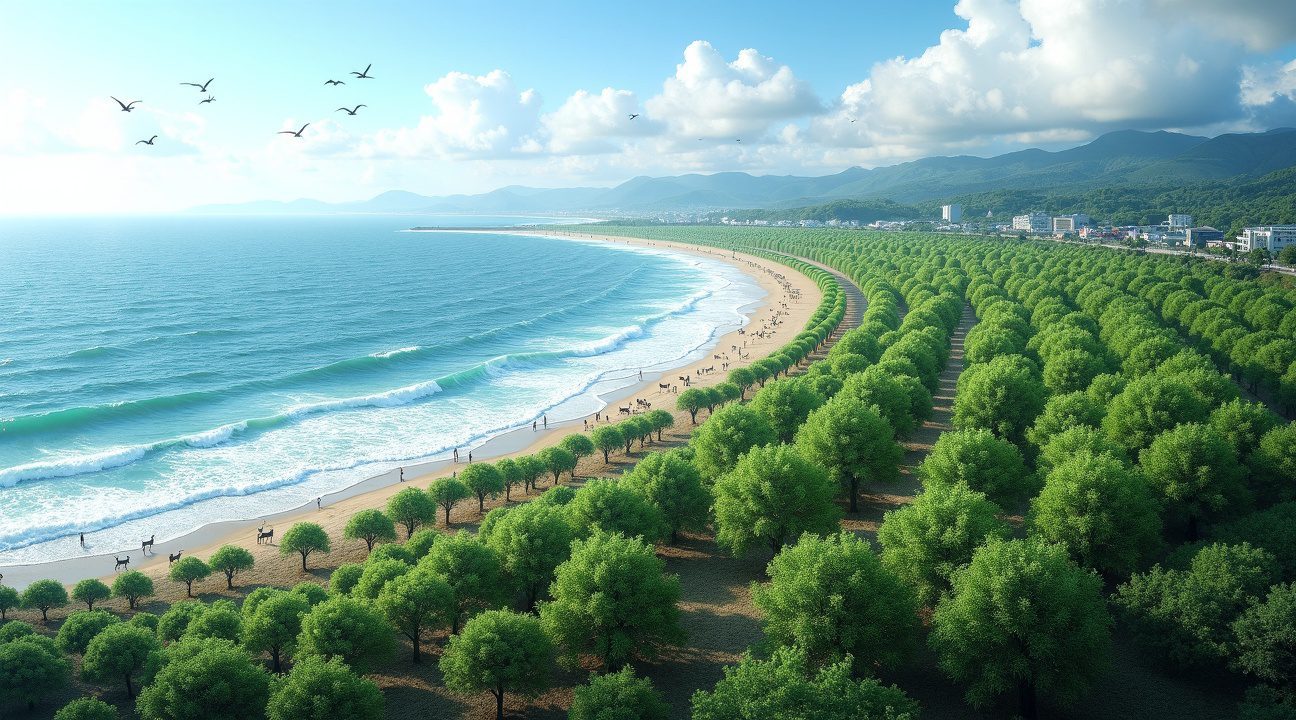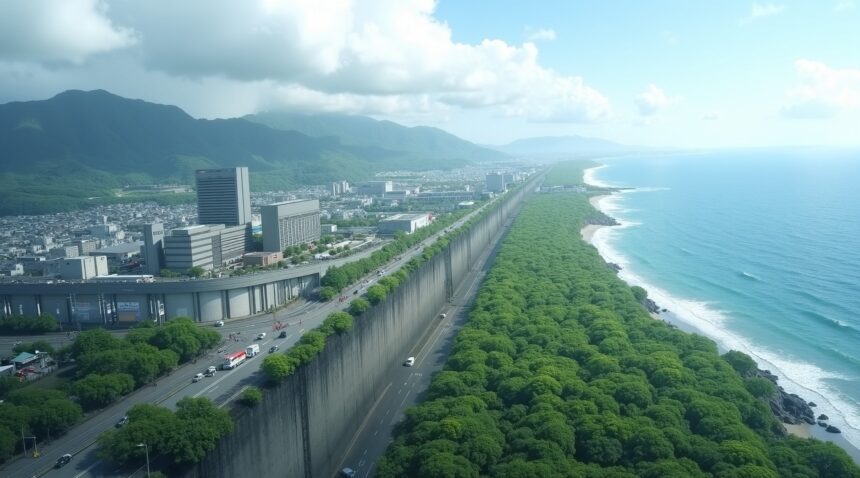Japan’s response to the catastrophic 2011 tsunami represents engineering ambition on an extraordinary scale.
The nation has constructed a 246-mile concrete barrier stretching from northern Iwate to southern Fukushima Prefecture at a staggering cost of $12-13 billion. Sections of this wall reach heights comparable to 4- or 5-story buildings, making it one of the most ambitious coastal defense systems in history according to experts.
This massive structure is complemented by a sweeping reforestation effort that has introduced over 9 million trees along the coastline. Together, these strategies serve as a hybrid defense system, combining engineered infrastructure with nature-based solutions. These efforts were mounted in response to the devastating 2011 tsunami, a disaster that claimed the lives of 20,000 people and exposed serious flaws in Japan’s previous coastal defenses.
Key Takeaways
- Japan built a 246-mile, $12-13 billion concrete tsunami wall with sections reaching 46-51 feet high and foundations going as deep as 82 feet underground—an astounding engineering feat.
- The country planted over 9 million coastal trees as natural tsunami barriers, capable of reducing wave height by up to 30% in addition to providing carbon sequestration and restoring habitats.
- The project has not been without controversy. Many local communities oppose the wall, citing blocked ocean views, disrupted tourism, and the belief that funds might have been better spent on relocating residents to higher ground.
- Japan’s multifaceted defense strategy includes:
- Early warning systems
- Evacuation routes
- Movable seawalls
- Strategic relocation of infrastructure to elevated areas
- The integrated approach is rooted in lessons from 2011, when existing seawalls between 6.5 and 13 feet tall failed disastrously against tsunami waves measuring up to 130 feet in height.
For more information on Japan’s continuing efforts to strengthen its coastal resilience, see this BBC report on Japan’s tsunami sea walls.
Japan’s $12 Billion Concrete Fortress: 246 Miles of Tsunami Defense
Japan has constructed one of the most ambitious coastal defense systems in history, stretching an impressive 246 miles along its Pacific coastline. This massive tsunami wall represents a $12-13 billion investment in protecting communities that experienced devastating losses during the Japan earthquake of 2011.
Engineering Marvel of Unprecedented Scale
The concrete barrier spans approximately 395 kilometers, creating a formidable defense against future tsunami threats. Construction crews have built sections reaching heights of 46-51 feet in critical areas, creating walls equivalent to 4-5 story buildings that tower above the coastline. These imposing structures extend deep underground, with foundations anchored up to 82 feet below ground level to ensure maximum stability against the incredible forces of incoming tsunami waves.
Engineers have incorporated significant design improvements based on lessons learned from the 2011 disaster. The upgraded specifications include:
- Wider foundation systems that distribute wave forces across larger areas
- Reinforced inner wall structures designed to absorb and dissipate energy
- Multi-layer construction techniques that allow the barrier to withstand successive wave impacts
- Strategic placement in areas identified as highest risk based on historical tsunami data
Geographic Coverage and Strategic Positioning
The reinforced seawall system extends from northern Iwate Prefecture down to southern Fukushima Prefecture, covering the regions that suffered the most severe damage during the 2011 tsunami. This strategic placement reflects careful analysis of coastal vulnerability and wave modeling data that identified these areas as requiring the highest level of protection.
Construction teams have adapted the wall’s design to local geographic conditions, with height variations that account for different risk levels and coastal topography. Some sections incorporate additional features like drainage systems and access points for emergency vehicles, ensuring the barrier serves multiple protective functions while maintaining community accessibility.
The project represents Japan’s commitment to engineered solutions for coastal defense, demonstrating how advanced construction techniques can create protective infrastructure on a massive scale. Each section undergoes rigorous testing and quality control measures to ensure the wall can perform as designed when facing the tremendous forces of tsunami waves.
This concrete fortress stands as a testament to Japan’s determination to protect its coastal communities through comprehensive engineering approaches. The wall’s construction has transformed hundreds of miles of coastline, creating a physical barrier that officials hope will significantly reduce casualties and property damage in future tsunami events.
The massive scale of this undertaking reflects Japan’s approach to disaster preparedness, combining traditional engineering expertise with modern materials science to create defensive infrastructure capable of withstanding nature’s most powerful forces. Local communities now live behind these towering concrete walls, representing a fundamental change in how Japan’s coastal areas interface with the Pacific Ocean.
Construction continues in some sections as engineers refine designs and incorporate new technologies that enhance the wall’s protective capabilities. The project has created thousands of jobs and stimulated local economies while building critical infrastructure that will serve communities for generations to come.

The 2011 Disaster That Changed Everything: From 130-Foot Waves to 20,000 Lives Lost
The magnitude 9.0 earthquake that struck off Japan’s coast on March 11, 2011, generated tsunami waves that reached heights exceeding 130 feet. These massive walls of water overwhelmed the country’s existing coastal defenses and claimed approximately 20,000 lives, making it one of the deadliest natural disasters in modern Japanese history.
Inadequate Defenses Against Nature’s Fury
Before the catastrophe, Japan’s seawalls measured only 6.5 to 13 feet high in many coastal areas. These barriers proved woefully inadequate against the devastating tsunami waves that followed the earthquake. The disaster also triggered the Fukushima nuclear crisis, adding another layer of complexity to an already devastating situation. I witnessed through news coverage how entire towns disappeared under the relentless surge of water, leaving behind scenes of complete destruction.
The catastrophe exposed critical flaws in Japan’s disaster preparedness strategy. Coastal communities that had relied on relatively modest seawalls found themselves defenseless against nature’s overwhelming force. The speed and height of the waves caught many residents off guard, despite Japan’s sophisticated early warning systems.
Engineering Revolution and Future Threats
Following the disaster, Japan adopted revolutionary engineering standards focused on strategic defense rather than absolute protection. The new approach emphasizes slowing tsunami advances and buying precious evacuation time—typically one to two extra minutes that can mean the difference between life and death. These additional moments allow residents to reach higher ground or reinforced evacuation centers.
Japan’s location on the Pacific Ring of Fire means the threat remains constant. Scientists estimate a 70 to 80 percent likelihood of another mega-thrust earthquake occurring in the Nankai Trough within the next 30 years. This sobering forecast has driven the country’s massive investment in tsunami defense infrastructure.
The 2011 disaster fundamentally changed how Japan approaches coastal protection. Rather than attempting to stop tsunamis entirely, engineers now focus on buying time and reducing wave energy. This pragmatic shift acknowledges that while complete protection against massive tsunamis may be impossible, strategic defenses can significantly reduce casualties and damage. The country’s commitment to this new philosophy reflects lessons learned from one of its darkest days, when the sea claimed thousands of lives in a matter of hours.

9 Million Trees as Nature’s Tsunami Shield: Japan’s Massive Coastal Reforestation
Japan’s monumental tree-planting initiative represents one of the most ambitious coastal reforestation projects ever undertaken. Following devastating natural disasters, including recent seismic events, the nation has committed to planting over 9 million trees along its vulnerable coastlines. This green wall serves as a living complement to the concrete barriers that stretch across hundreds of miles of Japanese shoreline.
How Coastal Forests Combat Tsunami Forces
The science behind using trees as tsunami defenses isn’t new, but Japan’s scale of implementation sets a global precedent. Dense coastal forests can reduce wave heights by up to 30% when strategically planted in multiple rows. These natural barriers work by creating friction that slows water velocity and breaks up the energy of incoming waves.
The tree selection process focuses on native species that can withstand saltwater exposure and high winds. Japanese black pine, tamarisk, and coastal oak dominate these plantings because they develop deep root systems that anchor soil and resist uprooting. These species also grow quickly, establishing protective coverage within five to seven years of planting.
Unlike rigid concrete structures, living forests adapt to changing conditions. They bend without breaking during storms, self-repair through natural growth, and become more effective over time as root systems expand and canopies thicken. This flexibility makes them particularly valuable as sea levels rise and storm patterns shift due to climate change.
Environmental Benefits Beyond Protection
The ecological advantages of this massive reforestation extend far beyond disaster mitigation. These coastal forests create crucial habitat corridors for migrating birds and provide nesting sites for species displaced by urban development. The restored ecosystems support biodiversity that had been lost to decades of coastal industrialization.
Carbon sequestration represents another significant benefit. Nine million mature trees can absorb approximately 180,000 tons of carbon dioxide annually, helping Japan meet its climate commitments while providing protection. This dual function demonstrates how environmental restoration can address multiple challenges simultaneously.
The forests also improve local air quality by filtering pollutants and producing oxygen. Communities near these plantings report reduced dust and improved microclimates, with trees providing cooling effects during hot summers and windbreaks during storms.
Water quality benefits emerge as root systems filter runoff before it reaches the ocean. The trees capture sediments and pollutants that would otherwise contribute to coastal degradation, protecting marine ecosystems and fishing grounds that remain vital to local economies.
Japan’s approach recognizes that future disaster preparedness requires integration of natural and engineered solutions. The country learned from the 2011 tsunami that concrete alone couldn’t provide complete protection. Some seawalls were overtopped or damaged, while areas with existing coastal forests experienced reduced damage even when artificial barriers failed.
Maintenance requirements for these living barriers differ significantly from concrete structures:
- Trees need periodic thinning
- Disease monitoring
- Replanting of damaged sections
However, the long-term costs remain lower than replacing and upgrading concrete barriers every few decades.
Community involvement has proven essential to the project’s success. Local volunteers participate in planting events, creating ownership and ensuring ongoing care. Schools integrate forest maintenance into environmental education programs, teaching children about both disaster preparedness and ecological stewardship.
The cultural significance of these forests resonates deeply with Japanese values. Traditional concepts of living harmoniously with nature, rather than simply controlling it, influence public support for the initiative. This cultural alignment helps ensure the project’s sustainability across generations.
International observers study Japan’s model for application in other tsunami-prone regions. The Philippines, Indonesia, and Chile have begun similar programs, adapting Japan’s techniques to local conditions and species. This knowledge transfer demonstrates how Japanese environmental practices continue influencing global approaches to disaster resilience.
The success of this reforestation effort depends on continued commitment and adaptive management. Climate change may alter growing conditions, requiring adjustments to species selection and planting strategies. However, the foundation has been established for a living coastal defense system that will grow stronger and more effective with time.

Communities Divided: The $12-17 Billion Controversy Over Japan’s Great Wall
Japan’s massive seawall project has created deep divisions across coastal communities, sparking heated debates about priorities, spending, and environmental impact. Despite its ambitious protective goals, the 246-mile barrier faces significant resistance from residents and environmental groups who question whether this enormous undertaking represents the best path forward.
Coastal communities express strong opposition to the wall’s visual and economic impact on their daily lives. The towering concrete structure blocks cherished ocean views that have defined these towns for generations, fundamentally altering the character of seaside settlements. Local tourism operators report declining visitor numbers as the wall transforms scenic coastal areas into industrial-looking barriers. Fisheries also struggle with the wall’s interference in traditional fishing practices and coastal access routes that have sustained these communities for decades.
Environmental and Economic Concerns
Critics raise serious concerns about the project’s staggering $12-17 billion price tag, arguing these resources could achieve better protection through alternative approaches. Activists advocate for relocating vulnerable residents to safer inland areas, suggesting this strategy would provide more reliable long-term security while preserving coastal ecosystems. Environmental groups highlight how the massive concrete barrier disrupts natural coastal processes, potentially affecting marine habitats and fish migration patterns that support local economies.
The wall also creates what experts describe as a dangerous false sense of security among residents. Communities living behind these defenses may become complacent about evacuation procedures and emergency preparedness, potentially increasing casualties if a tsunami exceeds the wall’s design capacity. Historical examples demonstrate that even the most advanced barriers can fail when faced with unprecedented natural forces, as witnessed during recent seismic events like the Japan earthquake 2024.
Opposition voices argue that Japan’s disaster preparedness strategy relies too heavily on engineering solutions rather than addressing fundamental vulnerabilities. They contend that moving people away from high-risk coastal zones would eliminate the need for expensive barriers while protecting both lives and natural environments. This approach would also free up resources for other climate adaptation measures, including early warning systems and community resilience programs.
Supporters counter that the wall provides immediate protection for millions of residents who cannot or will not relocate from established coastal communities. They emphasize that Japan’s dense population and limited inland space make mass relocation impractical for many areas. The wall’s defenders also point to successful protection during smaller tsunami events, demonstrating the barrier’s effectiveness within its design parameters.
The controversy reflects broader questions about how societies should respond to increasing climate risks and natural disasters. Japan’s experience with this massive infrastructure project offers valuable lessons for other nations facing similar challenges, particularly regarding the balance between technological solutions and community-based adaptation strategies.
These debates continue to shape policy discussions about future disaster preparedness in Japan and beyond. The seawall controversy illustrates how disaster mitigation efforts can create unexpected social divisions, even when designed with protective intentions. Communities must weigh immediate safety benefits against long-term environmental and economic consequences, while considering whether alternative approaches might achieve better outcomes.
The ongoing disagreements highlight the complex relationship between technological solutions and community values, demonstrating that effective disaster preparedness requires more than engineering expertise. Success depends on building consensus among diverse stakeholders who may have fundamentally different perspectives on risk, safety, and environmental stewardship. Japan’s experience shows that even well-intentioned protective measures can generate significant social tensions when they conflict with cultural values and economic interests.
Japan’s Multi-Layered Defense: Beyond Walls and Trees
Japan’s approach to tsunami preparedness creates a comprehensive defense system that integrates multiple protective measures rather than relying solely on physical barriers. The 246-mile fortified wall system works in concert with sophisticated evacuation routes that guide residents to safety zones within minutes of an alert. These pathways connect directly to higher elevation areas and reinforced buildings, ensuring communities can respond quickly when warning systems activate.
The country’s early warning network represents a technological achievement that complements the physical infrastructure. Tsunami sirens positioned throughout coastal regions provide immediate alerts, while upgraded detection systems monitor seismic activity and ocean conditions in real-time. This electronic defense layer gives residents crucial minutes to reach safety before waves arrive.
Strategic Relocation and Technological Innovation
Critical infrastructure relocation demonstrates Japan’s long-term commitment to disaster preparedness. Cities in affected regions have moved essential facilities like hospitals, government buildings, and emergency services to higher ground. This strategic repositioning reduces vulnerability while maintaining operational capacity during and after natural disasters.
Technological advances enhance traditional defense methods through dynamic solutions:
- Movable seawalls adjust automatically based on wave predictions and storm conditions
- Dynamic port gates seal harbor entrances when tsunami threats are detected
- Automated systems coordinate wall movements with evacuation procedures
- Smart sensors monitor structural integrity and environmental changes continuously
The integration of these technologies with existing infrastructure creates adaptive defenses that respond to changing conditions. Unlike static barriers, these systems can modify their protective stance based on real-time threat assessments.
Japan’s disaster-informed urban planning shapes new development projects and retrofits existing communities. Building codes now require tsunami-resistant construction in vulnerable areas, while zoning regulations prevent critical infrastructure placement in high-risk zones. This forward-thinking approach ensures future growth aligns with safety requirements.
Community resilience emerges from the combination of physical protection and public preparedness. Regular evacuation drills familiarize residents with escape routes, while educational programs teach recognition of natural warning signs. The cultural emphasis on collective responsibility strengthens community response capabilities during emergencies.
The ecological barrier component works alongside engineered solutions to absorb wave energy naturally. The 9 million trees planted create green buffers that slow tsunami force while providing environmental benefits during normal conditions. These living walls require less maintenance than concrete alternatives and improve local ecosystems.
Emergency response coordination links all defensive elements through centralized command systems. When sensors detect potential threats, automated protocols activate seawalls, trigger sirens, and notify emergency personnel simultaneously. This synchronized response maximizes protection effectiveness while minimizing human error during critical moments.
The multi-layered strategy acknowledges that no single solution can guarantee complete protection against extreme natural events. By combining concrete barriers, natural buffers, technological systems, and human preparedness, Japan creates redundant protection that maintains effectiveness even if individual components fail.
Investment in this comprehensive approach reflects lessons learned from past disasters, including the devastating 2011 tsunami. The country’s commitment extends beyond immediate protection to include long-term resilience planning that adapts to changing climate conditions and emerging threats.
Monitoring and maintenance programs ensure all system components remain operational and effective. Regular inspections identify potential weaknesses while upgrade schedules incorporate new technologies and improved materials. This ongoing attention maintains defense capabilities at peak performance levels.
The success of Japan’s multi-layered approach influences coastal protection strategies worldwide. Other nations study these integrated systems to develop their own comprehensive defense networks, recognizing that effective tsunami preparedness requires coordination between multiple protective elements rather than dependence on individual solutions.
Sources:
en.as.com
WATOP YouTube
Threads


